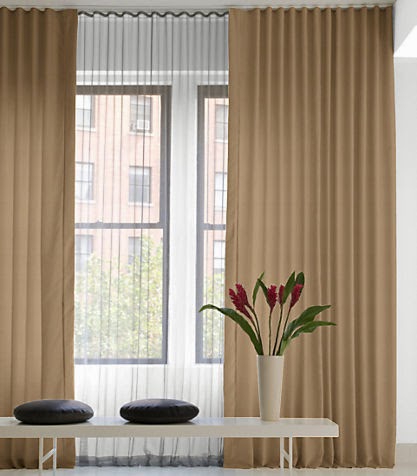There's nothing like custom drapery to finish a space, to soften the bare hard edges of window casings, and to add extra color, pattern, and texture to a room. But there are so many ways to finish draperies, and so many options to consider. Of course some of these decisions will be driven by your individual style preferences and what kind of look we are trying to create. Below are ten basic ways to finish the top of a drapery panel; there are even more esoteric flourishes and variations on these ten, but for now, they will get us started.
1) Pinch Pleat
I think this is probably the one most all of us are familiar with. The classic pinch pleat is just that: the fabric is pinched together a few inches below the top and stitched together so the fabric falls in waves from each pinch. This style can come in two finger pleats (first image), classic three finger pleats (second image), all the way up to five finger pleats.
2) Euro Pinch Pleat
This style is also sometimes referred to as Parisian or French Pleats. Instead of the pinch being stitched a few inches down, it is stitched at the top. The result is similar to a classic Pinch Pleat but the waves fall from the very top. As you can see, there is also the option for two, three, or more pleats.
3) Pencil Pleat
Instead of fingers like in the previous pleat styles, these panels have continuous pleats all along the top of the panel.
4) Inverted Pleat
Imagine pleating a piece of fabric but facing out the reverse side. This creates a nice, structured, almost architectural drapery panel.
5) Goblet Pleat
This pleat style is so named because of its rsemblance to a drinking goblet. The rounded shape is achieved by inserting cardboard or tissue paper into the hollow for the goblet to keep its shape.
6) Ripplefold
Although the second pleat on this list is called the Euro Pinch Pleat, the Ripplefold is by far the more European styled drapery. Its clean lines are elegant, modern but timeless, and can go with any type of interior. It is quickly becoming the choice here in the States. Ripplefold panels installed on a hidden or flush track at the ceiling line are truly lovely (it makes a lower ceiling look taller) and I have done several sets for clients.
7) Grommet
This extremely casual style is rather rustic and useful in family rooms, game rooms, cabins or boat houses.
8) Rod Pocket
This style can be found on off-the-shelf drapery panels at retail stores and tends to look messy. Because the top of the panel is not truly finished, the fabric unfortunately does not hang uniformly.
9) Tab Top
Again, a very casual style good for breakfast rooms, garden rooms, or outdoor loges. The inherent trouble with a tab top though is the difficulty in pulling the panels open or closed since the fabric tends not to slide freely on the rod.
10) Tie Top
Possibly the most casual style of all, a tie top can look good in spaces that are emulating a kind of Bohemian/Parisian cafe look but just like a tab top, the panels do not slide freely.
Like I said at the start of this post, there are variations on what we see here, but these basic ten are used most in drapery fabrication.
If you have some bare windows or want a new look for your home, let's create some gorgeous custom window treatments made especially for you.
Happy designing!













No comments:
Post a Comment